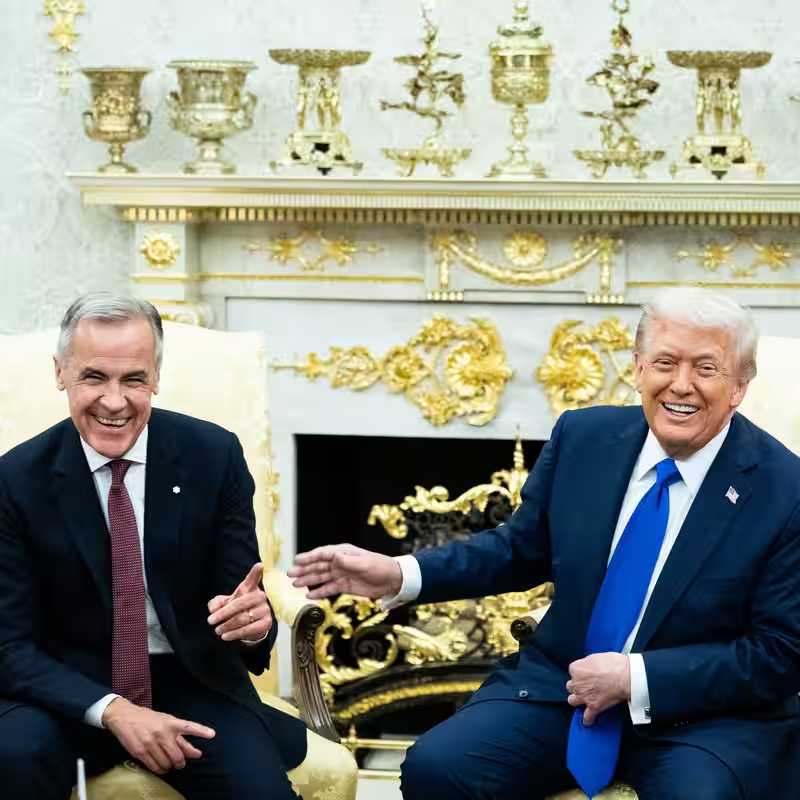Table of Contents
- A Delicate Mission to Washington
- The Looming Threat of U.S. Tariffs
- Carney’s Quiet Diplomacy Pays Off
- But Trump Couldn’t Resist a Few Swipes
- What’s Next for U.S.-Canada Relations?
- Sources
A Delicate Mission to Washington
When Canadian Prime Minister Mark Carney stepped off the plane in Washington this week, he wasn’t just carrying a briefcase—he was carrying the weight of North America’s most critical bilateral relationship.
With President Trump ramping up threats of new tariffs on Canadian steel, aluminum, and even softwood lumber, tensions between the two neighbors had reached a boiling point. But Carney, a former central banker turned statesman, came with one clear mission: de-escalate.
And by most accounts, he succeeded—at least for now.
The Looming Threat of U.S. Tariffs
Trump has long viewed trade deficits as a sign of weakness, and Canada—despite being America’s largest trading partner—hasn’t been spared his ire. In recent weeks, the president floated the idea of a 25% tariff on all Canadian exports unless Ottawa made “serious concessions” on energy and defense spending.
“They’ve been taking advantage of us for decades,” Trump told reporters just days before Carney’s visit. “It stops now.”
For Canada, the stakes couldn’t be higher. Over 75% of its exports go to the U.S., and a full-blown trade war could shave billions off its GDP—and cost thousands of jobs in manufacturing and agriculture.
Carney’s Quiet Diplomacy Pays Off
Unlike flashier world leaders, Carney opted for a low-key, data-driven approach. In private meetings with Trump and key cabinet officials, he emphasized shared interests: joint energy infrastructure, continental defense through NORAD, and the $2.7 billion in trade that crosses the U.S.-Canada border every single day.
He also made subtle concessions—agreeing to explore increased Canadian purchases of American liquefied natural gas and reaffirming commitments to meet NATO defense targets.
“This isn’t about winning or losing,” Carney told Canadian reporters afterward. “It’s about recognizing that our economies are woven together. When one frays, both unravel.”
The result? Trump paused the tariff threat—calling the talks “very productive” and praising Carney as “a smart guy who gets it.”
But Trump Couldn’t Resist a Few Swipes
Still, no Trump encounter is complete without a barb. During a press gaggle, the president couldn’t help but jab at Canada’s climate policies: “They talk a big game on emissions, but they’re still pumping oil like it’s 1985.”
He also revived an old grievance about dairy tariffs, calling Canada’s supply management system “a total rip-off.”
Carney, ever the technocrat, didn’t take the bait. “We’ll keep talking,” he said with a calm smile. “That’s what allies do.”
What’s Next for U.S.-Canada Relations?
Experts warn that the truce is fragile. Trump’s “America First” agenda hasn’t softened, and with the 2026 midterms looming, he may need foreign targets to rally his base.
“Carney bought time, not peace,” said Dr. Lena Patel, a trade policy fellow at the Brookings Institution. “The structural tensions—on energy, autos, and digital services—are still there.”
Yet Carney’s visit did something more important: it reminded both nations that diplomacy, not tweets, is how lasting partnerships survive.
As one senior Canadian official put it: “We didn’t win a victory. We avoided a disaster.”




